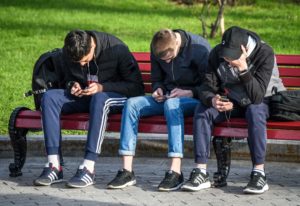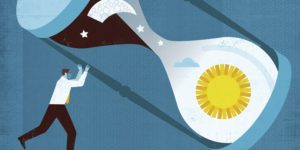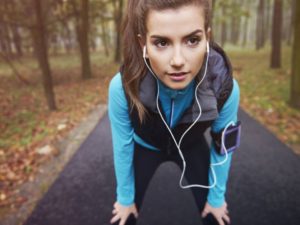Nina Langton had no right to be depressed. At least, that’s how she saw it.
She had a great group of friends, lived in a prosperous neighborhood, and was close with her parents. Like most 16-year-olds at her Connecticut high school, Nina spent much of her free time on her smartphone. But unlike many of her classmates, she was never “targeted” on social media—her word for the bullying and criticism that took place daily on sites like Snapchat. “Part of what made my depression so difficult was that I didn’t understand why I was feeling so sad,” she says.
Later, after her attempted suicide and during her stay at a rehabilitation facility, Nina and her therapist identified body image insecurity as the foundation of her woe. “I was spending a lot of time stalking models on Instagram, and I worried a lot about how I looked,” says Nina, who is now 17. She’d stay up late in her bedroom, looking at social media on her phone, and poor sleep—coupled with an eating disorder—gradually snowballed until suicide felt like her only option. “I didn’t totally want to be gone,” she says. “I just wanted help and didn’t know how else to get it.”
Nina’s mom, Christine Langton, has a degree in public health and works at a children’s hospital. Despite her professional background, she says she was “completely caught off guard” by her daughter’s suicide attempt. “Nina was funny, athletic, smart, personable . . . depression was just not on my radar,” she says.

Nina, TIME Magazine
In hindsight, Langton says she wishes she had done more to moderate her daughter’s smartphone use. “It didn’t occur to me not to let her have the phone in her room at night,” she says. “I just wasn’t thinking about the impact of the phone on her self-esteem or self-image until after everything happened.”
It seems like every generation of parents has a collective freak-out when it comes to kids and new technologies; television and video games each inspired widespread hand-wringing among grown-ups. But the inescapability of today’s mobile devices—coupled with the personal allure of social media—seems to separate smartphones from older screen-based media. Parents, teens and researchers agree smartphones are having a profound impact on the way adolescents today communicate with one another and spend their free time. And while some experts say it’s too soon to ring alarm bells about smartphones, others argue we understand enough about young people’s emotional and developmental vulnerabilities to recommend restricting kids’ escalating phone habit.
The latest statistics on teen mental health underscore the urgency of this debate.
Between 2010 and 2016, the number of adolescents who experienced at least one major depressive episode leapt by 60%, according to a nationwide survey conducted by the U.S. Department of Health and Human Services. The 2016 survey of 17,000 kids found that about 13% of them had a major depressive episode, compared to 8% of the kids surveyed in 2010. Suicide deaths among people age 10 to 19 have also risen sharply, according to the latest data from the Centers for Disease Control and Prevention. Young women are suffering most; a CDC report released earlier this year showed suicide among teen girls has reached 40-year highs. All this followed a period during the late-1990s and early 2000s when rates of adolescent depression and suicide mostly held steady or declined.
“These increases are huge—possibly unprecedented,” says Jean Twenge, a professor of psychology at San Diego State University and author of iGen, which examines how today’s super-connected teens may be less happy and less prepared for adulthood than past generations. In a peer-reviewed study that will appear later this year in the journal Clinical Psychological Science, Twenge shows that, after 2010, teens who spent more time on new media were more likely to report mental health issues than those who spent time on non-screen activities.
Using data collected between 2010 and 2015 from more than 500,000 adolescents nationwide, Twenge’s study found kids who spent three hours or more a day on smartphones or other electronic devices were 34% more likely to suffer at least one suicide-related outcome—including feeling hopeless or seriously considering suicide—than kids who used devices two hours a day or less. Among kids who used electronic devices five or more hours a day, 48% had at least one suicide-related outcome.
Twenge also found that kids who used social media daily were 13% more likely to report high levels of depressive symptoms than those who used social less frequently. Overall, kids in the study who spent low amounts of time engaged in in-person social interaction, but high amounts of time on social media, were the most likely to be depressed.
Twenge is quick to acknowledge that her research does not prove a cause-and-effect relationship exists between smartphones and depression. “It’s possible that depressed kids are just more likely to spend time on their devices,” she says. “But that doesn’t answer the question of what caused this sudden upswing in teen depression and suicide.”
Some experts have pointed to the aftermath of the Great Recession, or rising student workloads, as possible non-device explanations for young people’s recent struggles. “But when you look at the economic or homework data, it doesn’t line up with the rise in teen suicide or depression,” Twenge says. Youth smartphone ownership does. “I’m open to exploring other factors, but I think the more we learn about kids and smartphones, the more we’re going to see that limiting their exposure is a good idea.”
Others agree it’s time to approach adolescent device use with greater caution. “What this generation is going through right now with technology is a giant experiment, and we don’t know what’s going to happen,” says Frances Jensen, chair of neurology at the University of Pennsylvania’s Perelman School of Medicine. While the science on kids and technology is incomplete, Jensen says what we already know about the minds of tweens and teens suggests giving a young person all-the-time access to an Internet-connected device “may be playing with fire.”
The teenage brain
To understand how device use may be affecting a young person’s mental health, it’s important to recognize the complex changes occurring in an adolescent’s still-developing brain.
For one thing, that brain is incredibly plastic and able to adapt—that is, physically change—in response to novel activities or environmental cues, says UPenn’s Jensen, who is the author of The Teenage Brain.
Some research has already linked media multitasking—texting, using social media and rapidly switching among smartphone-based apps—with lower gray-matter volume in the brain’s anterior cingulate cortex (ACC), a region involved in emotion processing and decision making. More research has associated lower ACC volumes with depression and addiction disorders.
“We know for a fact teens have very underdeveloped impulse control and empathy and judgment compared to adults,” Jensen says. This may lead them to disturbing online content or encounters—stuff a more mature mind would know to avoid. Teens also have a hyperactive risk-reward system that allows them to learn—but also to become addicted—much more quickly than grown-ups, she says. Research has linked social media and other phone-based activities with an uptick in feel-good neurochemicals like dopamine, which could drive compulsive device use and promote feelings of distraction, fatigue, or irritability when kids are separated from their phones.
Even if smartphones aren’t the root cause of a teen’s anxiety or other issues, Jensen adds, they may turn out to be an accelerant—the gasoline that turns a flicker of adolescent angst into a blaze.
Another area of the brain—the prefrontal cortex—is critical for focus and interpreting human emotion, and doesn’t fully develop until a person’s mid-20s, says Paul Atchley, a professor of psychology at the University of Kansas. “During our teenage years, it’s important to train that prefrontal cortex not to be easily distracted,” he says. “What we’re seeing in our work is that young people are constantly distracted, and also less sensitive to the emotions of others.”
While the research on smartphones is preliminary, Atchley says he believes studies will eventually show a clearer connection between the negative trends in teen mental health and rising smartphone use. But some scientists contend there isn’t enough cause-and-effect evidence to condemn smartphones.
“I see the rise in depression, especially among girls, and I understand why people are making these connections with new technologies,” says Candice Odgers, a professor of psychology and neuroscience at Duke University who has published research on teens and tech. “But so far, we have very little data to suggest mobile technologies are causing anxiety or social impairments.” She points to evidence that some young people, particularly marginalized groups like LGBT youth, can derive benefits from online communication through supportive exchanges with friends and family.
Odgers adds that jumping to conclusions and vilifying smartphones may lead us away from factors that may turn out to be more significant—a worry raised by other experts. “This is such a serious and polarizing issue that I think we need to set aside our assumptions until we have stronger data,” she says. At the same time, she doesn’t condone unrestricted smartphone access at any age. “I’m certainly not advocating giving an 8-year-old a smartphone,” she says. “But if you ask me what age is appropriate, or how much use is safe, I don’t think the existing evidence provides those answers.”
As researchers debate appropriate public health messaging, kids are receiving their first smartphone at ever-younger ages—the average is 10, according to one recent estimate—and they’re spending more and more time on their devices.
“I am probably on my phone 10 hours a day,” says Santi Potočnik Senarighi, a 16-year-old eleventh grader in Denver. Even when he’s not actively using his phone, Santi says it’s always with him, and he never considers taking a break. “This is part of my life and part of my work, and [that] means I need to be in constant contact.”
Santi’s dad, Billy Potočnik, says he worries about his son’s phone habit, as Santi is struggling in school. But every one of Santi’s friends has a smartphone and uses it constantly, and so Potočnik says confiscating his son’s phone feels oppressive. “If I try to take it away from him, he tells me he’s not doing anything bad on it,” which Potočnik says is usually true, “and it turns into a struggle.”
He and other parents say enduring that struggle day after day feels overwhelming. And to complicate matters, many schools and after-school groups now use social media or online platforms to coordinate events, or to post grades and homework. “It’s not as simple as saying, okay, time to take a break from your phone,” Potočnik says.
How teens ‘talk’
Colleen Nisbet has been a high school guidance counselor for more than two decades. One of her duties at Connecticut’s Granby Memorial High School is to monitor students during their lunch periods. “Lunch was always a very social time when students were interacting and letting out some energy,” she says. “Now they sit with their phones out and barely talk to each other.”
This scene—of kids collecting in parks or at one another’s houses only to sit silently and stare at screens—comes up over and over again when talking with parents and kids. “When you’re with people you don’t know well or there’s nothing to talk about, phones are out more because it’s awkward,” says Shannon Ohannessian, a 17-year-old senior at Farmington High School in Connecticut.
That avoidance of face-to-face interaction worries Brian Primack, director of the University of Pittsburgh’s Center for Research on Media, Technology, and Health. “Human beings are social animals,” he says. “We evolved over millions of years to respond to eye contact and touch and shared laughter and real things right in front of us.” There’s strong research linking isolation to depression, and time spent socializing with improved mood and well-being. If smartphones are getting between an adolescent and her ability to engage in and enjoy face-to-face interaction—and some studies suggest that’s happening—that’s a big deal, Primack says.
But while they’re not always speaking out loud, kids today are talking to each other—and about each other. They’re just doing it on their phones. Not all that talk is friendly. “They tell me they’re making comments or criticizing each other to friends while they’re all sitting together,” says Nisbet, the guidance counselor. Something about the phone just seems to “take the filter off,” she adds.
Backbiting and mean-girl gossip are nothing new, of course. But research suggests that, even among adults, the Internet has a disinhibition effect that leads people to speak in coarser, crueler ways then they would offline.
Maryellen Pachler, a Yale-trained nurse practitioner who specializes in the treatment of adolescent anxiety disorders, says her job used to involve convincing her patients that their fears were largely irrational. “Now I don’t think they’re irrational at all,” she says. “If you raise your hand in class or say something silly, I think it’s likely your classmates will be texting or posting something about it.”
She says the glamor and gleam of social media is also fueling a rise in teen anxiety. “My patients see their friends’ Snapchat or Instagram photos where they look so happy, and they feel like they’re the only ones who are faking it,” she says, referencing what researchers call the highlight reel effect of social media. “I want to tell them, listen, this girl you’re jealous of—she was in here with me yesterday!”
Teens agree social-media whitewashing is the rule, not the exception. “No one’s going to post something that makes them look bad,” Ohannessian says. “I know that, but it’s still hard to separate what you see on social media from real life.”
What’s next for teens and phones
There are doubtless many factors contributing to teen depression. Parents say kids today are busier than ever before—their lives increasingly crammed with the extracurriculars required to gain admission to a good college. But even those researchers who aren’t ready to slam smartphones say it’s important to restrict an adolescent’s device habit, and that too much social media or media multitasking is likely harmful.
“I don’t think these devices are the main cause, but I think they contribute to a lot of the things we worry about,” says David Hill, director of the American Academy of Pediatrics (AAP) Council on Communications and Media. “I speak to parents who are very concerned, and my take is to be much more rigid about setting limits—especially when it comes to phones in the bedroom at night.”
But the AAP’s current guidelines do not offer specifics when it comes to appropriate smartphone limits for children older than 6, and public health officials generally say parents should decide what is right for their kids, without offering specifics.
Educators are also grappling with smartphone-related dilemmas. Most schools allow smartphone use between classes and during free periods, but teachers say keeping students off their phones during class has become a tremendous burden.
Gina Spiers, an English teacher at San Lorenzo High School near Oakland, Calif., says she used to confiscate phones, but students would panic and cause a disruption in class. She and her school are fighting back—with encouraging results.
Starting this fall, San Lorenzo High joined several schools nationwide in working with a company called Yondr to restrict smartphone access during school hours. Yondr makes small, lockable phone pouches that students keep with them, but that can’t be opened until the end of the day.
“The changes have already been profound,” says Allison Silvestri, San Lorenzo’s principal. Kids are more focused and engaged during class, and student journals suggest the high schoolers are feeling less anxious and more relaxed. Silvestri says fewer fights have broken out this semester—a benefit she attributes to the absence of social media. “They have to look each other in the eye to make conflict happen,” she says. “There’s so much more joy and interaction, and I can’t count the number of parents who have asked me, ‘How do I buy this for my home?’”
The smartphone experiment at San Lorenzo doesn’t meet the standards of the scientific method. But it’s one more piece of evidence linking mobile devices with the troubles today’s teen are facing. While there are no doubt helpful and healthy ways young people could use smartphones to enrich their lives, it’s becoming harder to argue that the status quo—near-ubiquitous teen smartphone ownership, coupled with more-or-less unfettered Internet access—is doing kids good.
A few months after her suicide attempt, Nina Langton addressed her high school classmates and spoke openly about her depression. She described the stigma of mental illness, and lamented the fact that, while many teens experience depression, very few are willing to talk about it or ask for help. “I was worried for so long about opening up about my struggles because I thought I would be judged,” she said.
After she gave the speech, “so many people my age reached out to me about their own experiences with technology and depression and therapy,” she says. “I think this is a big problem that needs to be talked about more.”
SOURCE: http://time.com/4974863/kids-smartphones-depression/






















